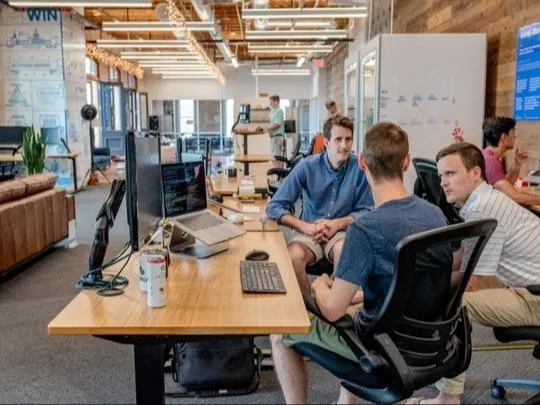
No Help Wanted
The 2020 pandemic set off a tsunami of labor disruptions and massive reshuffling of the employment market. First, government officials around the nation in 2020 followed health agencies' direction by passing mandates for nearly all businesses to close and send their employee home. Then came the outcry from employers and employees about how they were going to pay their bills if no one was working or buying. Shortly after the stock market bottomed in March 2020, President Trump signed the hastily written Paycheck Protection Program Flexibility Act in June, establishing the $953 Billion Paycheck Protection Program (PPP) program.
The PPP was an unprecedented government subsidy program in which, according to NPR, over 11.4 recipients received forgivable loans from $20K to millions within months after President Trump signed the bill. The SBA oversaw the program appointing banks to process loans who received a 4% application fee for their work. Suddenly, a new short-lived, highly profitable chaotic industry merged as frantic business owners working with their bankers, who had very little guidance on how to approve the loans, had a chance to earn some of the $38M SBA-issued commissions. It was the most convoluted free for all money grab I have ever experienced. Lines out the door of business owners waiting to meet their bankers, all during a time of social distancing and mask mandates. We somehow navigated through the process for our five companies that all qualified for loans. The second wave of chaos was the loan forgiveness process with little guidance again from the SBA. I thankfully have our loan forgiveness certificates safely stored should anyone come knocking on our doors.
While employers were getting billions of government subsidies, including the PPP loans, individuals were already navigating through a dizzying process of unemployment benefits. In March 2020, President Trump signed the Coronavirus Aid, Relief and Economic Security (CARES) Act, providing Americans with new and expanded unemployment insurance benefits if they're out of work for reasons related to the pandemic (meaning everyone). These benefits were updated and extended when the Continued Assistance for Unemployed Workers Act of 2020 (Continued Assistance Act) was signed by President Trump on December 27, 2020.
We wrote in our September 9, 2021, Weekly Brief titled "Labor Day":
"The nation's employment sector continues to improve each month after last year's historic business shutdown that ended payrolls for a reported 19,731 million people (see chart below). The rebound of people returning to work has been steady, with another 243,000 new payrolls added in August. December last year was the only month excluding March and April with fewer new payrolls due to a non-existent holiday season with Covid-related restrictions."

The US economy was on a steady recovery in 2021, along with the labor market. However, government unemployment subsidies kept millions of potential employees at home. The result is the largest gap between available jobs vs. applicants in recorded history.
We wrote in the August 9, 2022, Weekly Brief titled, "Jobs, Jobs, Jobs":
"I can't remember any time in my lifetime the extreme abundance of jobs. Almost everywhere I go, there are "Help Wanted" signs in business windows, billboards advertising signing bonuses, and even messages of "We're Hiring!" on the sides of trucks….However, the US labor force participation rate that counts anyone 16 years or older is still well below pre-pandemic levels. As the US economy has been bouncing back from the massive 2020 whipsaw of companies closing and then re-opening, millions of people have not returned to "work." They seem to have disappeared as they are not collecting unemployment benefits and not showing up on W-2 payroll reports."

Like any boom cycle, there is always a bust. Jerome Powell and his Federal Open Market Committee (FOMC) started their rate hike campaign in March 2022 to slow inflation. After 16 months of rate hikes, the inflation of products has slowed significantly from the 2022 peak. However, the FOMC is also concerned about the impact of fast-rising wages due to labor shortages. If employers keep raising wages to hire new employees, they will have no option but to raise their rates on their goods and services. As you know, many entry-level jobs have starting pay of $11 to $21 per hour, with companies like Starbucks, In N Out, and Chick Fil A hiring with no experience near the top of these hourly ranges.
Wage growth needs to slow for the Fed to hold rates steady as they feel like inflation is on track to their target goal. The stock market and institutional investors are betting that inflation of both goods and wages will stabilize at sub 4% by the end of 2023 and end rate increases by the Federal Reserve. Wage growth can be the biggest driver of inflation, and if the labor market can stabilize, so will inflation.
Today the seam front page article in the Wall Street Journal is "Companies Cut Pay for New Hires as Shortages of Workers Eases." In the article, it states:
"Wages, especially for people who changed jobs, climbed in recent years as companies competed for workers to fill pandemic-induced labor shortages. Now, as the job market cools and businesses become more cautious in their hiring, many companies are paying new recruits less than they did just months ago – in some cases, much less."
The labor market went through booming years pre-pandemic, a bust in 2020, and then a boom recovery. A wild whipsaw cycle for many people trying to navigate their household budgets. Now it appears the labor market is finally stabilizing as the ratio of job openings vs. eligible applicants is narrowing.
WHAT DOES IT MEAN TO ME?
Institutional investors' biggest fears for the past two years are the impact of rising interest rates due to the Federal Reserve rate hike campaign to slow inflation. Now that a recession appears to be a low probability, investors' new fear is if the Fed will resume more rate hikes if inflation appears to be heating up. Wage growth will be a major factor in rising inflation going into 2024, and investors will be encouraged by reports that employers are slowing their hiring and wage increases.
The major indices have been trending down since July 31 for a much-needed pause after the first half-year rally. The S&P 500 and NASDAQ are now below both their 20-Day Moving Average (DMA) and 50 DMA. This is setting up for good buying opportunities going into what we project to be a positive uptrend in the fourth quarter of 2023 and possibly into 2024.


Give us a call or send an email with your thoughts about this Weekly Brief. We welcome the opportunity to assist you and your family in achieving your financial and investing goals.
CONTACT
Check the background of your financial professional on FINRA's BrokerCheck.
The content is developed from sources believed to be providing accurate information. The information in this material is not intended as tax or legal advice. Please consult legal or tax professionals for specific information regarding your individual situation. Some of this material was developed and produced by FMG Suite to provide information on a topic that may be of interest. FMG Suite is not affiliated with the named representative, broker - dealer, state - or SEC - registered investment advisory firm. The opinions expressed and material provided are for general information, and should not be considered a solicitation for the purchase or sale of any security.
We take protecting your data and privacy very seriously. As of January 1, 2020 the California Consumer Privacy Act (CCPA) suggests the following link as an extra measure to safeguard your data: Do not sell my personal information.
The information on this website is the opinion of Up Capital Management and does not constitute investment advice or an offer to invest or to provide management services. Before purchasing any investment, a prospective investor should consult with its own investment, accounting, legal, and tax advisers to evaluate independently the risks, consequences, and suitability of any investment.
Copyright 2024 | Privacy Policy | Terms & Conditions

